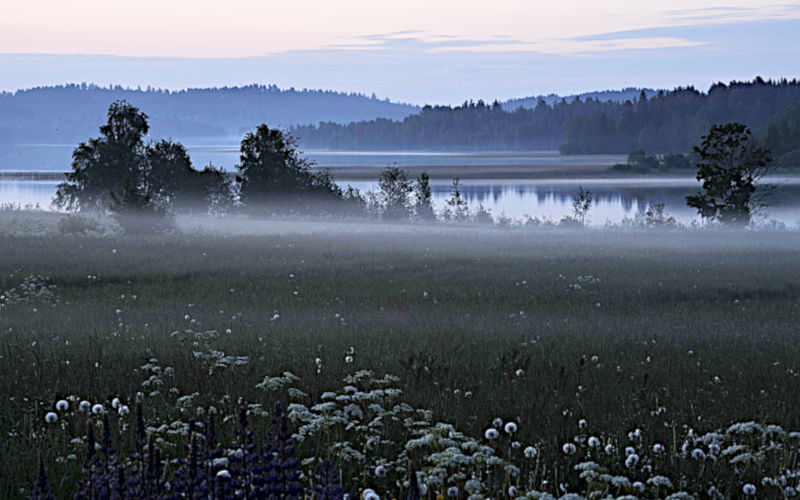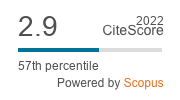Comparing conservation value maps and mapping methods in a rural landscape in southern Finland
DOI:
https://doi.org/10.3097/LO.201544Keywords:
Ecosystem services, GIS, Habitat type, Naturalness, Species richnesAbstract
We tested to what extent conservation value maps are different if the valuation and mapping method is changed. We compared 66 different conservation value and 4 different ecosystem service maps. Using remote sensing and other georeferenced data, we produced 2 different habitat type maps, which were 50 % similar. We valued each mapped habitat type based on rarity corrected potential number of vascular plant species and naturalness using 6 different valuation alternatives. We mapped habitat type connectivity and complementarity using 2 main approaches. The habitat type valuation alternatives were quite similar, but if the habitat type naturalness was taken into account, differences were larger (correlations between maps 0.38- 1.00). Different connectivity and complementarity calculations yielded different results, variation between different approaches being larger (correlations -0.15-0.44) than inside an approach (correlations 0.31-0.60). Conservation value maps were very different from ecosystem service maps (carbon storage, timber production potential, landscape value for recreation) (correlations -0.29-0.47). We show that valuation and mapping approach has a large effect on the conservation value map and the correlation between ecosystem service and conservation value maps depends on the used mapping approach. As different mapping approaches provide different maps, maps should be used with care.
References
Ahti, T., Hämet-Ahti, L., & Jalas, J. (1968). Vegetation zones and their sections in northwestern europe. Ann.Bot.Fenn., 5, 169-211.
Angermeier, P. L. (2000). The natural imperative for biological conservation. Conservation Biology, 14(2), 373-381. doi:10.1046/j.1523-1739.2000.98362.x
Arponen, A., Lehtomäki, J., Leppänen, J., Tomppo, E., & Moilanen, A. (2012). Effects of connectivity and spatial resolution of analyses on conservation prioritization across large extents. Conservation Biology, 26(2), 294-304. doi:10.1111/j.1523-1739.2011.01814.x
Breiman, L. (2001). Random forests. Machine Learning, 45(1), 5-32. doi:10.1023/A:1010933404324
Burkhard, B., Kroll, F., Nedkov, S., & Müller, F. (2012). Mapping ecosystem service supply, demand and budgets. Ecological Indicators, 21, 17-29. doi:10.1016/j.ecolind.2011.06.019
Daily, G. C. (1997). Nature's Services: Societal Dependence on Natural Ecosystems,
Egoh, B., Drakou, E. G., Dunbar, M. B., Maes, J., & Willemen, L. (2012). Indicators for mapping ecosystem services: A review. Indicators for Mapping Ecosystem Services: A Review,
Eigenbrod, F., Armsworth, P. R., Anderson, B. J., Heinemeyer, A., Gillings, S., Roy, D. B., . . . Gaston, K. J. (2010). The impact of proxy-based methods on mapping the distribution of ecosystem services. Journal of Applied Ecology, 47(2), 377-385. doi:10.1111/j.1365-2664.2010.01777.x
Hämet-Ahti, L., Suominen, J., Ulvinen, T., Uotila, P., & Vuokko, S. (1986). Retkeilykasvio,
Hanski, I. (2000). Extinction debt and species credit in boreal forests: Modelling the consequences of different approaches to biodiversity conservation. Annales Zoologici Fennici, 37(4), 271-280.
Hilli, M., & Kuitunen, M. T. (2005). Testing the use of a land cover map for habitat ranking in boreal forests. Environmental Management, 35(4), 505-516. doi:10.1007/s00267-003-0301-1
Honnay, O., Piessens, K., Van Landuyt, W., Hermy, M., & Gulinck, H. (2003). Satellite based land use and landscape complexity indices as predictors for regional plant species diversity. Landscape and Urban Planning, 63(4), 241-250. doi:10.1016/S0169-2046(02)00194-9
Kaltenborn, B. P., & Bjerke, T. (2002). Association between environmental value orientations and landscape preferences. Landscape and Urban Planning, 59(1), 1-11. doi:10.1016/S0169-2046(01)00243-2
Kerr, J. T., & Ostrovsky, M. (2003). From space to species: Ecological applications for remote sensing. Trends in Ecology and Evolution, 18(6), 299-305. doi:10.1016/S0169-5347(03)00071-5
Kopperoinen, L., Itkonen, P., & Niemelä, J. (2014). Using expert knowledge in combining green infrastructure and ecosystem services in land use planning: An insight into a new place-based methodology. Landscape Ecology, 29(8), 1361-1375. doi:10.1007/s10980-014-0014-2
Kuitunen, T. (2013). Luopioisten Kasvisto,
Lavorel, S., Grigulis, K., Lamarque, P., Colace, M., Garden, D., Girel, J., . . . Douzet, R. (2011). Using plant functional traits to understand the landscape distribution of multiple ecosystem services. Journal of Ecology, 99(1), 135-147. doi:10.1111/j.1365-2745.2010.01753.x
Lehtomäki, J., Tomppo, E., Kuokkanen, P., Hanski, I., & Moilanen, A. (2009). Applying spatial conservation prioritization software and high-resolution GIS data to a national-scale study in forest conservation. Forest Ecology and Management, 258(11), 2439-2449. doi:10.1016/j.foreco.2009.08.026
Lucas, R., Medcalf, K., Brown, A., Bunting, P., Breyer, J., Clewley, D., . . . Blackmore, P. (2011). Updating the phase 1 habitat map of wales, UK, using satellite sensor data. ISPRS Journal of Photogrammetry and Remote Sensing, 66(1), 81-102. doi:10.1016/j.isprsjprs.2010.09.004
Machado, A. (2004). An index of naturalness. Journal for Nature Conservation, 12(2), 95-110. doi:10.1016/j.jnc.2003.12.002
Maes, J., Egoh, B., Willemen, L., Liquete, C., Vihervaara, P., Schägner, J. P., . . . Bidoglio, G. (2012). Mapping ecosystem services for policy support and decision making in the european union. Ecosystem Services, 1(1), 31-39. doi:10.1016/j.ecoser.2012.06.004
Margules, C., & Usher, M. B. (1981). Criteria used in assessing wildlife conservation potential: A review. Biological Conservation, 21(2), 79-109. doi:10.1016/0006-3207(81)90073-2
Margules, C. R., & Pressey, R. L. (2000). Systematic conservation planning. Nature, 405(6783), 243-253. doi:10.1038/35012251
Mas, J. -., Gao, Y., & Pacheco, J. A. N. (2010). Sensitivity of landscape pattern metrics to classification approaches. Forest Ecology and Management, 259(7), 1215-1224. doi:10.1016/j.foreco.2009.12.016
McDermid, G. J., Franklin, S. E., & LeDrew, E. F. (2005). Remote sensing for large-area habitat mapping. Progress in Physical Geography, 29(4), 449-474. doi:10.1191/0309133305pp455ra
McGarigal, K., Cushman, S. A., & Ene, E. (2012). FRAGSTATS v4: Spatial Pattern Analysis Program for Categorical and Continuous Maps,
McGarigal, K., Tagil, S., & Cushman, S. A. (2009). Surface metrics: An alternative to patch metrics for the quantification of landscape structure. Landscape Ecology, 24(3), 433-450. doi:10.1007/s10980-009-9327-y
Moilanen, A., Franco, A. M. A., Early, R. I., Fox, R., Wintle, B., & Thomas, C. D. (2005). Prioritizing multiple-use landscapes for conservation: Methods for large multi-species planning problems. Proceedings of the Royal Society B: Biological Sciences, 272(1575), 1885-1891. doi:10.1098/rspb.2005.3164
Moilanen, A., Kujala, H., & Leathwick, J. R. (2009). The zonation framework and software for conservation prioritization. Spatial Conservation Prioritization: Quantitative Methods and Computational Tools, , 196-210.
Moilanen, A., Meller, L., Leppänen, J., Montesino Pouzols, F., Arponen, A., & Kujala, H. (2012). Zonation - spatial conservation planning framework and software. Spatial Conservation Planning Framework and Software Zonation,
Moilanen, A., Wilson, K. A., & Possingham, H. P. (2009). Spatial Conservation Prioritization: Quantitative Methods and Computational Tools,
Moilanen, A., & Wintle, B. A. (2006). Uncertainty analysis favours selection of spatially aggregated reserve networks. Biological Conservation, 129(3), 427-434. doi:10.1016/j.biocon.2005.11.006
Nagendra, H. (2001). Using remote sensing to assess biodiversity. International Journal of Remote Sensing, 22(12), 2377-2400. doi:10.1080/01431160117096
Nelson, E., Mendoza, G., Regetz, J., Polasky, S., Tallis, H., Cameron, D. R., . . . Shaw, M. R. (2009). Modeling multiple ecosystem services, biodiversity conservation, commodity production, and tradeoffs at landscape scales. Frontiers in Ecology and the Environment, 7(1), 4-11. doi:10.1890/080023
Newton, A. C., Hill, R. A., Echeverría, C., Golicher, D., Benayas, J. M., Cayuela, L., & Hinsley, S. A. (2009). Remote sensing and the future of landscape ecology. Progress in Physical Geography, 33(4), 528-546. doi:10.1177/0309133309346882
Paillet, Y., Bergès, L., HjÄltén, J., Ódor, P., Avon, C., Bernhardt-Römermann, M., . . . Virtanen, R. (2010). Biodiversity differences between managed and unmanaged forests: Meta-analysis of species richness in europe. Conservation Biology, 24(1), 101-112. doi:10.1111/j.1523-1739.2009.01399.x
Räsänen, A., Kuitunen, M., Tomppo, E., & Lensu, A. (2014). Coupling high-resolution satellite imagery with ALS-based canopy height model and digital elevation model in object-based boreal forest habitat type classification. ISPRS Journal of Photogrammetry and Remote Sensing, 94, 169-182. doi:10.1016/j.isprsjprs.2014.05.003
Raudsepp-Hearne, C., Peterson, G. D., & Bennett, E. M. (2010). Ecosystem service bundles for analyzing tradeoffs in diverse landscapes. Proceedings of the National Academy of Sciences of the United States of America, 107(11), 5242-5247. doi:10.1073/pnas.0907284107
Rossi, E., & Kuitunen, M. (1996). Ranking of habitats for the assessment of ecological impact in land use planning. Biological Conservation, 77(2-3), 227-234. doi:10.1016/0006-3207(95)00139-5
Schindler, S., Poirazidis, K., & Wrbka, T. (2008). Towards a core set of landscape metrics for biodiversity assessments: A case study from dadia national park, greece. Ecological Indicators, 8(5), 502-514. doi:10.1016/j.ecolind.2007.06.001
Schulp, Burkhard, B., Maes, J., Van Vliet, J., & Verburg, P. H. (2014). Uncertainties in ecosystem service maps: A comparison on the european scale. PLoS ONE, 9(10) doi:10.1371/journal.pone.0109643
Smith, P. G. R., & Theberge, J. B. (1986). A review of criteria for evaluating natural areas. Environmental Management, 10(6), 715-734. doi:10.1007/BF01867726
Spanhove, T., Vanden Borre, J., Delalieux, S., Haest, B., & Paelinckx, D. (2012). Can remote sensing estimate fine-scale quality indicators of natural habitats? Ecological Indicators, 18, 403-412. doi:10.1016/j.ecolind.2012.01.025
Spellerberg, I. F. (1992). Evaluation and assessment for conservation: Ecological guidelines for determining priorities for nature conservation. Evaluation and Assessment for Conservation: Ecological Guidelines for Determining Priorities for Nature Conservation,
Sundell-Turner, N. M., & Rodewald, A. D. (2008). A comparison of landscape metrics for conservation planning. Landscape and Urban Planning, 86(3-4), 219-225. doi:10.1016/j.landurbplan.2008.03.001
Tomppo, E., Katila, M., Mäkisara, K., & Peräsaari, J. (2013). The multi-source national forest inventory of finland – methods and results 2009. The Multi-Source National Forest Inventory of Finland - Methods and Results 2005,
Tomppo, E. O., Gagliano, C., De Natale, F., Katila, M., & McRoberts, R. E. (2009). Predicting categorical forest variables using an improved k-nearest neighbour estimator and landsat imagery. Remote Sensing of Environment, 113(3), 500-517. doi:10.1016/j.rse.2008.05.021
Troy, A., & Wilson, M. A. (2006). Mapping ecosystem services: Practical challenges and opportunities in linking GIS and value transfer. Ecological Economics, 60(2), 435-449. doi:10.1016/j.ecolecon.2006.04.007
Turner, W., Spector, S., Gardiner, N., Fladeland, M., Sterling, E., & Steininger, M. (2003). Remote sensing for biodiversity science and conservation. Trends in Ecology and Evolution, 18(6), 306-314. doi:10.1016/S0169-5347(03)00070-3
Vanden Borre, J., Paelinckx, D., Mücher, C. A., Kooistra, L., Haest, B., De Blust, G., & Schmidt, A. M. (2011). Integrating remote sensing in natura 2000 habitat monitoring: Prospects on the way forward. Journal for Nature Conservation, 19(2), 116-125. doi:10.1016/j.jnc.2010.07.003
Vihervaara, P., Kumpula, T., Ruokolainen, A., Tanskanen, A., & Burkhard, B. (2012). The use of detailed biotope data for linking biodiversity with ecosystem services in finland. International Journal of Biodiversity Science, Ecosystem Services and Management, 8(1-2), 169-185. doi:10.1080/21513732.2012.686120
Villarroya, A., & Puig, J. (2012). Valuation of residual impacts of roads on landscape ecological units in navarre, spain. Journal of Environmental Planning and Management, 55(3), 339-353. doi:10.1080/09640568.2011.597974
Williams, P., Gibbons, D., Margules, C., Rebelo, A., Humphries, C., & Pressey, R. (1996). A comparison of richness hotspots, rarity hotspots, and complementary areas for conserving diversity of british birds. Conservation Biology, 10(1), 155-174. doi:10.1046/j.1523-1739.1996.10010155.x

Downloads
Additional Files
Published
How to Cite
Issue
Section
License
Copyright (c) 2019 Aleksi Räsänen, Anssi M. Lensu, Erkki O. Tomppo, Markku Tapio Kuitunen

This work is licensed under a Creative Commons Attribution 4.0 International License.










